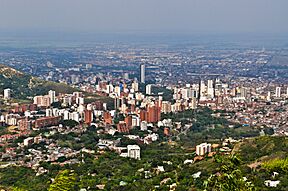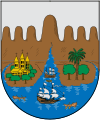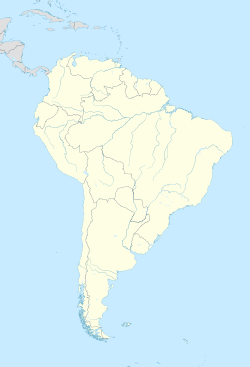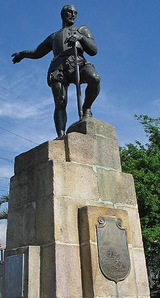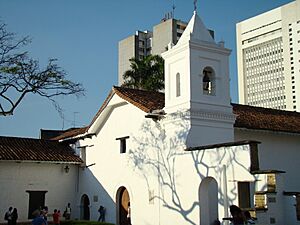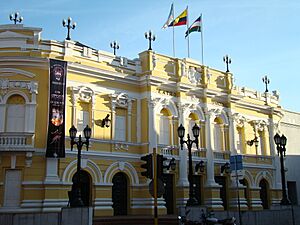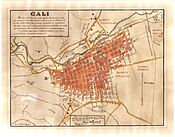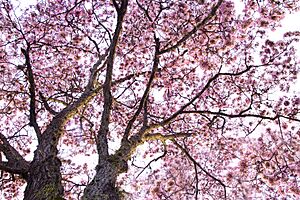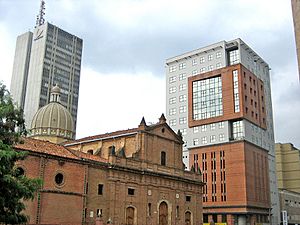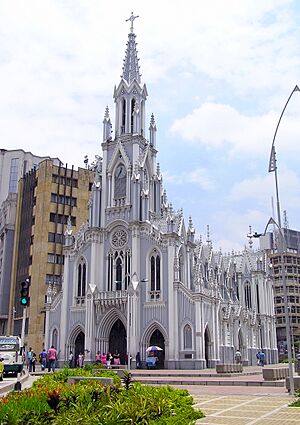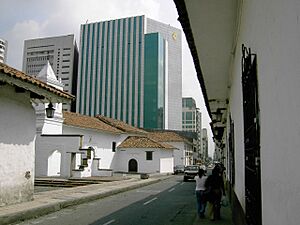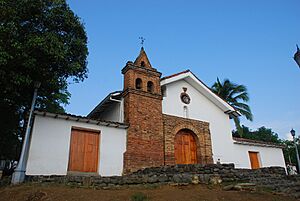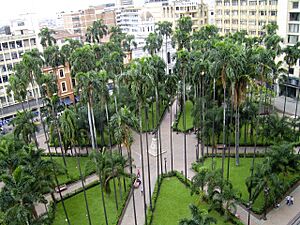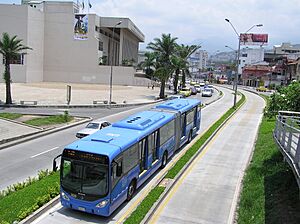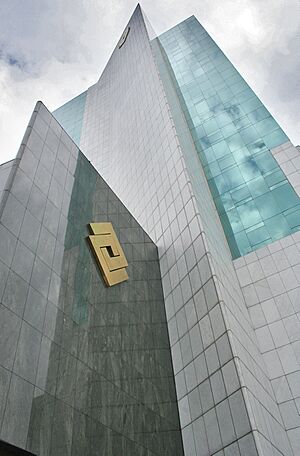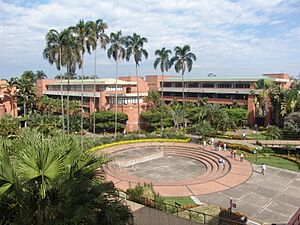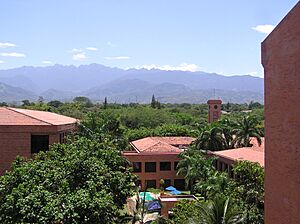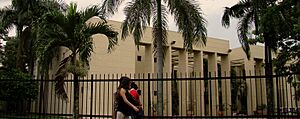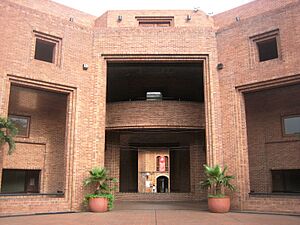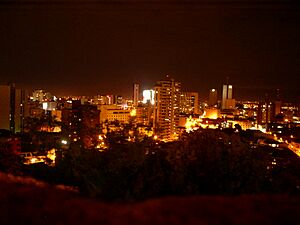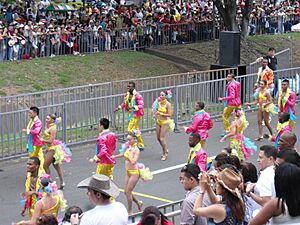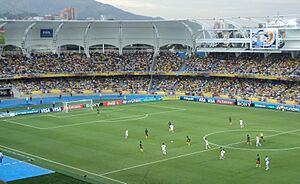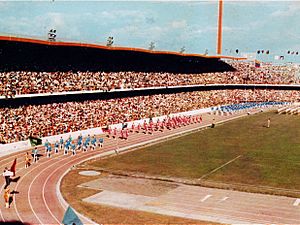Cali facts for kids
Quick facts for kids
Cali
|
|||
|---|---|---|---|
|
District and city
|
|||
| Santiago de Cali | |||
|
|
|||
|
|||
| Nicknames:
La capital mundial de la salsa (The Salsa capital of the world)
Capital de la felicidad (Capital of Happiness) Capital deportiva de Colombia (Sports Capital of Colombia) Sucursal del cielo (Branch of heaven) La sultana del Valle (The Sultana of the Valley) |
|||
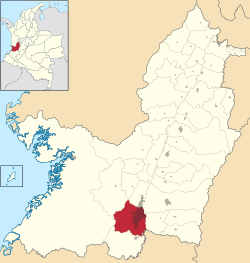
Location of the municipality and city of Cali in the Valle del Cauca Department
|
|||
| Country | Colombia | ||
| Department | Valle del Cauca | ||
| Foundation | 25 July 1536 | ||
| Founded by | Sebastián de Belalcázar | ||
| Area | |||
| • District and city | 619 km2 (239 sq mi) | ||
| Elevation | 1,018 m (3,340 ft) | ||
| Population
(2023 projection)
|
|||
| • District and city | 2,234,400 | ||
| • Rank | Ranked 3rd | ||
| • Density | 3,609.7/km2 (9,349/sq mi) | ||
| • Urban | 2,838,333 | ||
| • Metro | 2,890,433 | ||
| Demonym(s) | Caleño | ||
| GDP (PPP, constant 2015 values) | |||
| • Year | 2023 | ||
| • Total | $45.9 billion | ||
| • Per capita | $15,900 | ||
| Time zone | UTC-5 (COT) | ||
| Area code(s) | +57 602 | ||
| Website | Official website: http://www.cali.gov.co/ | ||
Santiago de Cali, usually called Cali, is a big city in southwest Colombia. It is the capital of the Valle del Cauca department. In 2023, about 2.2 million people lived there.
Cali is the third most populated city in Colombia. Only Bogotá and Medellín are larger. It's also the second-largest city by land area. Cali is very important because it's the only major Colombian city close to the Pacific Coast. This makes it a key center for business and trade in the south of the country.
The city was founded a long time ago, on July 25, 1536. A Spanish explorer named Sebastián de Belalcázar started it. Cali is also known as the "Sports Capital of Colombia." It has hosted many big sports events. These include the 1971 Pan American Games and the World Games 2013.
Contents
What does the name Cali mean?
Cali is a shorter way to say Santiago de Cali. "Santiago" honors Saint James. His special day is celebrated on July 25. This is the same day the city was founded. The name "Cali" comes from the local native people, the "Calima" tribe.
A brief look at Cali's past
How Cali began: Early tribes and settlers

Before the Spanish arrived, different native tribes lived in the Cali area. One important group was the Gorrones. They lived between the Cauca River and the Western mountains. They traded with the Quimbayas, another tribe.
When Sebastián de Belalcázar and his Spanish soldiers came, they met tribes like the Timbas and Jamundíes. The Jamundíes fought bravely with poisonous darts. But the Spanish, with their guns and swords, eventually won.
Belalcázar founded Santiago de Cali on July 25, 1536. He chose this area because it was outside the Inca empire. This meant he could claim it as his own territory.
Cali during colonial times
Sebastián de Belalcázar was an explorer who came to America with Columbus. He helped conquer Peru before coming to Colombia. He founded Cali, and later, the city was moved to its current spot in 1537.
For a long time, Cali was a small town. Most of the land around it was used for large farms called haciendas. These farms grew sugar cane and raised animals. Many enslaved African people worked on these haciendas. Cali was a good place for trade because it was between important mining areas.
Cali fights for independence
On July 3, 1810, Cali decided it would no longer follow the Spanish rulers. This happened even before the main independence movement in Bogotá. The people of Cali joined with other nearby towns. They formed the Confederated cities of the Cauca Valley. They declared independence from Spanish rule in 1811.
Many battles were fought between the Spanish army and the local fighters. In 1819, after Simón Bolívar won a big battle, the people of Cali finally gained full control. Bolívar himself visited Cali in 1822. The city played a big part in helping other nations in the south become free.
Cali in modern times
In the 1800s, Cali was a quiet town with less than 20,000 people. Its center was around the Altozano and San Antonio areas. The economy was based on livestock, sugar, and gold.
Later, a market plaza was built, which helped trade grow. A public transportation system called the tranvia (trolley) also connected the city. In the 1900s, Cali grew into an industrial city. Many factories opened, including some big international companies. This brought many people to live in Cali in the 1950s and 1960s.
On August 7, 1956, a big explosion happened near the train station. Trucks carrying dynamite exploded, destroying many city blocks. Many people were hurt or lost their lives. The next year, the city started the Cali Fair to help people feel better and to boost the economy.
In 1971, Cali hosted the 1971 Pan American Games. This was a huge event for the city. It helped Cali become known as the Sports Capital of Colombia. In 1982, the "La Torre de Cali" (The Cali Tower) was built. It's a very tall building with offices and a hotel.
In 2021, there were protests in Colombia, and Cali was a main center for them. Some protests were peaceful, but there were also clashes. A statue of Sebastián de Belalcázar was taken down. The city's public transport system, MIO, was also damaged.
Cali's location and weather
Where is Cali located?
Cali is in the Cauca Valley. It's west of the Cauca River and east of the Western Mountain Range. The city is about 1,000 meters (3,280 feet) above sea level. About 100 kilometers (62 miles) west of Cali, over the mountains, is the port city of Buenaventura on the Pacific coast.
To the northeast is the industrial city of Yumbo. Cali's international airport, Alfonso Bonilla Aragón, is also there. It's Colombia's third-busiest airport.
Cali is mostly flat, but the western parts have mountains. The Farallones de Cali mountains are very close to the city. Several rivers flow from these mountains through Cali and into the Cauca River. The Pance River in the south is a popular spot for fun and relaxation.
Cali's climate and seasons
Cali has a tropical climate. This means it's warm all year round. The average temperature is about 24°C (75°F). The Western Mountain Range affects the weather. The northwest part of the city is drier than the southwest.
Because Cali is near the equator, it doesn't have four distinct seasons like winter or summer. Instead, locals call the dry season "summer." During this time, temperatures can reach 30-34°C (86-93°F). The rainy season, or "winter," sees temperatures around 28-30°C (82-86°F).
There are usually two rainy seasons: from March to May and from October to November. But it can rain at any time of the year. This helps keep the city's plants green and lush.
| Climate data for Cali (Alfonso Bonilla Aragón International Airport), elevation 961 m (3,153 ft), (1991–2020) | |||||||||||||
|---|---|---|---|---|---|---|---|---|---|---|---|---|---|
| Month | Jan | Feb | Mar | Apr | May | Jun | Jul | Aug | Sep | Oct | Nov | Dec | Year |
| Record high °C (°F) | 36.3 (97.3) |
36.5 (97.7) |
36.4 (97.5) |
33.2 (91.8) |
32.8 (91.0) |
33.2 (91.8) |
34.4 (93.9) |
35.0 (95.0) |
34.5 (94.1) |
33.7 (92.7) |
32.0 (89.6) |
32.8 (91.0) |
36.5 (97.7) |
| Mean daily maximum °C (°F) | 30.3 (86.5) |
30.6 (87.1) |
30.2 (86.4) |
29.8 (85.6) |
29.6 (85.3) |
29.8 (85.6) |
30.5 (86.9) |
31.1 (88.0) |
30.6 (87.1) |
29.6 (85.3) |
29.2 (84.6) |
29.5 (85.1) |
30.1 (86.2) |
| Daily mean °C (°F) | 24.0 (75.2) |
24.2 (75.6) |
24.2 (75.6) |
23.9 (75.0) |
23.9 (75.0) |
23.9 (75.0) |
24.1 (75.4) |
24.3 (75.7) |
24.1 (75.4) |
23.5 (74.3) |
23.4 (74.1) |
23.6 (74.5) |
23.9 (75.0) |
| Mean daily minimum °C (°F) | 18.9 (66.0) |
19.1 (66.4) |
19.2 (66.6) |
19.3 (66.7) |
19.3 (66.7) |
18.9 (66.0) |
18.6 (65.5) |
18.5 (65.3) |
18.6 (65.5) |
18.7 (65.7) |
18.9 (66.0) |
18.9 (66.0) |
18.9 (66.0) |
| Record low °C (°F) | 14.4 (57.9) |
15.4 (59.7) |
14.6 (58.3) |
14.6 (58.3) |
16.2 (61.2) |
15.1 (59.2) |
13.6 (56.5) |
13.4 (56.1) |
14.2 (57.6) |
15.0 (59.0) |
15.1 (59.2) |
15.0 (59.0) |
13.4 (56.1) |
| Average precipitation mm (inches) | 47.6 (1.87) |
54.0 (2.13) |
89.2 (3.51) |
134.2 (5.28) |
103.1 (4.06) |
49.7 (1.96) |
32.1 (1.26) |
28.7 (1.13) |
64.6 (2.54) |
99.2 (3.91) |
105.0 (4.13) |
68.5 (2.70) |
875.9 (34.48) |
| Average precipitation days (≥ 1 mm) | 5.7 | 6.4 | 10.0 | 12.1 | 11.0 | 6.3 | 5.0 | 4.5 | 6.8 | 11.0 | 10.8 | 7.9 | 97.5 |
| Average relative humidity (%) | 73 | 72 | 73 | 76 | 76 | 75 | 73 | 71 | 72 | 75 | 76 | 75 | 74 |
| Mean monthly sunshine hours | 179.8 | 158.1 | 161.2 | 141.0 | 142.6 | 150.0 | 182.9 | 189.1 | 159.0 | 155.0 | 153.0 | 164.3 | 1,936 |
| Mean daily sunshine hours | 5.8 | 5.6 | 5.2 | 4.7 | 4.6 | 5.0 | 5.9 | 6.1 | 5.3 | 5.0 | 5.1 | 5.3 | 5.3 |
| Source: Instituto de Hidrologia Meteorologia y Estudios Ambientales (mean temperature, humidity, sun 1971-2010) | |||||||||||||
| Climate data for Cali (Marco Fidel Suárez Air Base), elevation 954 m (3,130 ft), (1981–2010) | |||||||||||||
|---|---|---|---|---|---|---|---|---|---|---|---|---|---|
| Month | Jan | Feb | Mar | Apr | May | Jun | Jul | Aug | Sep | Oct | Nov | Dec | Year |
| Mean daily maximum °C (°F) | 30.2 (86.4) |
30.4 (86.7) |
30.3 (86.5) |
29.8 (85.6) |
29.5 (85.1) |
29.4 (84.9) |
30.2 (86.4) |
31.0 (87.8) |
30.4 (86.7) |
29.8 (85.6) |
29.0 (84.2) |
29.1 (84.4) |
30.0 (86.0) |
| Daily mean °C (°F) | 25.3 (77.5) |
25.4 (77.7) |
25.4 (77.7) |
25.0 (77.0) |
25.2 (77.4) |
25.1 (77.2) |
25.4 (77.7) |
25.8 (78.4) |
25.5 (77.9) |
24.8 (76.6) |
24.6 (76.3) |
24.6 (76.3) |
25.2 (77.4) |
| Mean daily minimum °C (°F) | 19.7 (67.5) |
19.7 (67.5) |
19.8 (67.6) |
19.9 (67.8) |
19.9 (67.8) |
19.6 (67.3) |
19.4 (66.9) |
19.5 (67.1) |
19.5 (67.1) |
19.5 (67.1) |
19.6 (67.3) |
19.7 (67.5) |
19.7 (67.5) |
| Average precipitation mm (inches) | 74.8 (2.94) |
61.2 (2.41) |
94.2 (3.71) |
139.8 (5.50) |
132.9 (5.23) |
66.7 (2.63) |
47.7 (1.88) |
40.3 (1.59) |
69.9 (2.75) |
119.9 (4.72) |
117.9 (4.64) |
83.6 (3.29) |
1,048.8 (41.29) |
| Average precipitation days | 9 | 9 | 13 | 15 | 14 | 10 | 8 | 7 | 11 | 16 | 13 | 12 | 130 |
| Average relative humidity (%) | 71 | 71 | 72 | 75 | 75 | 73 | 70 | 67 | 69 | 73 | 74 | 75 | 72 |
| Source: Instituto de Hidrologia Meteorologia y Estudios Ambientales | |||||||||||||
| Climate data for Cali (University of Valle), elevation 985 m (3,232 ft), (1981–2010) | |||||||||||||
|---|---|---|---|---|---|---|---|---|---|---|---|---|---|
| Month | Jan | Feb | Mar | Apr | May | Jun | Jul | Aug | Sep | Oct | Nov | Dec | Year |
| Mean daily maximum °C (°F) | 30.0 (86.0) |
30.3 (86.5) |
30.2 (86.4) |
29.6 (85.3) |
29.4 (84.9) |
29.6 (85.3) |
30.3 (86.5) |
31.1 (88.0) |
30.7 (87.3) |
29.5 (85.1) |
29.0 (84.2) |
29.2 (84.6) |
29.9 (85.8) |
| Daily mean °C (°F) | 24.5 (76.1) |
24.7 (76.5) |
24.7 (76.5) |
24.4 (75.9) |
24.4 (75.9) |
24.4 (75.9) |
24.7 (76.5) |
25.1 (77.2) |
24.8 (76.6) |
24.1 (75.4) |
23.8 (74.8) |
24.1 (75.4) |
24.5 (76.1) |
| Mean daily minimum °C (°F) | 19.4 (66.9) |
19.5 (67.1) |
19.6 (67.3) |
19.6 (67.3) |
19.6 (67.3) |
19.2 (66.6) |
18.7 (65.7) |
18.7 (65.7) |
19.0 (66.2) |
19.1 (66.4) |
19.2 (66.6) |
19.4 (66.9) |
19.2 (66.6) |
| Average precipitation mm (inches) | 102.7 (4.04) |
109.5 (4.31) |
149.6 (5.89) |
191.3 (7.53) |
162.7 (6.41) |
89.4 (3.52) |
63.0 (2.48) |
51.0 (2.01) |
103.0 (4.06) |
160.7 (6.33) |
170.2 (6.70) |
130.3 (5.13) |
1,483.4 (58.40) |
| Average precipitation days | 12 | 12 | 15 | 18 | 16 | 12 | 10 | 9 | 13 | 18 | 18 | 14 | 164 |
| Average relative humidity (%) | 72 | 71 | 72 | 76 | 76 | 74 | 70 | 67 | 69 | 74 | 75 | 74 | 72 |
| Mean monthly sunshine hours | 167.4 | 146.8 | 155.0 | 138.0 | 142.6 | 156.0 | 186.0 | 186.0 | 153.0 | 139.5 | 135.0 | 148.8 | 1,854.1 |
| Mean daily sunshine hours | 5.4 | 5.2 | 5.0 | 4.6 | 4.6 | 5.2 | 6.0 | 6.0 | 5.1 | 4.5 | 4.5 | 4.8 | 5.1 |
| Source: Instituto de Hidrologia Meteorologia y Estudios Ambientales | |||||||||||||
Fun places to visit in Cali
| Cali Tower | |
|---|---|
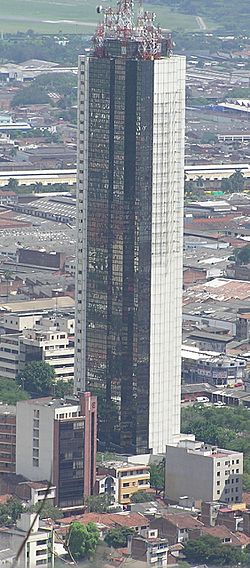 |
|
| General information | |
| Coordinates | 3°27′32.40″N 76°31′44.4″W / 3.4590000°N 76.529000°W |
| Completed | 1984 |
| Design and construction | |
| Architect | Jaime Vélez |
| Developer | Julián Echeverri cía. |
| Structural engineer | Enrique Martínez Romero |
Cali has many historical places and fun attractions. You can explore old churches and beautiful squares.
Exploring Cali's historic center
The downtown area of Cali has many old churches. Two famous ones are La Merced and La Ermita. Cali also has a well-preserved historic center.
The most important spot is Plaza de Cayzedo. This square is the heart of the city. It's surrounded by old and new buildings. These include El edificio Otero, La Catedral, and El Palacio de Justicia. Near this plaza, you can find other interesting places. These are the Saint Francis church, the municipal theater, and La Merced church.
Cali also has many statues, parks, and museums. Some famous statues are Cristo Rey on a mountain. There's also a statue of Sebastián de Belalcázar, the city's founder. Las Tres Cruces is a special place for religious visits.
Other exciting places to see
Here are some other popular places to visit in Cali:
- Plaza de Caicedo: This is the main square in downtown Cali. It's named after a local hero, Joaquín de Caicedo y Cuero.
- Parque del Perro: Located in the San Fernando neighborhood. This park is very popular and has many restaurants and bars. It's named after a dog monument in the middle.
- Sebastian de Belalcázar's monument: This is the most visited statue in the city. It's on a hill overlooking Cali. The statue is famous for pointing away from the valley.
- Cali River: The river flows through the west side of the city. It's surrounded by restaurants, hotels, and museums. One is La Tertulia, an art museum.
- El Gato del Río: This is a sculpture of a cat by Hernando Tejada. It's located right next to the Cali River.
- Cristo Rey: A large religious statue on a hill. It offers the best views of the city. It's 31 meters (102 feet) tall.
- Boulevard del Río Cali: This is a walking area along the Cali River in the historic center. It's about 980 meters (3,215 feet) long.
- San Antonio: This is a very old and traditional neighborhood. It's on a hill, and at the top, you'll find San Antonio Park.
- Farallones de Cali: Part of the city is on hills that are part of the Colombian western mountains. Beyond these hills is the Farallones de Cali national park.
- Cerro de las Tres Cruces: The Three Crosses monument is on a hill 1,480 meters (4,856 feet) above sea level. Visitors can hike up for great city views.
Getting around Cali
Airports near Cali
Cali is served by the Alfonso Bonilla Aragón International Airport (CLO). It's located in the nearby city of Palmira. This airport is Colombia's third-largest for passengers. It's in a long valley surrounded by tall mountains. A highway connects the airport to Cali.
The Marco Fidel Suárez Air Base is a military airport. It's close to downtown Cali and used for training fighter pilots.
Public transportation in Cali
Cali has different ways to get around. The main system is the Masivo Integrado de Occidente (MIO). It started in 2009. The MIO uses special buses that run on dedicated lanes. They have stations connected by pedestrian crossings or bridges.
The MIO system also includes a cable car line called MÍO Cable. This cable car helps people get around the Siloé district. Taxis are also available and are a safe way for tourists to travel.
On average, people in Cali spend about 88 minutes commuting on public transit each weekday. About 23% of riders travel for more than 2 hours daily.
Bus station
Cali has a Central Bus Station. It's located near the old railway station. Many bus companies operate from here. They offer rides to different destinations using various types of buses.
Cali's economy
Cali and the Valle del Cauca region are a major economic hub in Colombia. The city is an important stop for trade with Ecuador. It also connects to the rest of the world through the port of Buenaventura.
In the early 1900s, Cali's economy focused on sugar production. Large farms grew sugar cane. Later, the city became a commercial center. A railway to Buenaventura was built, which helped trade.
In the 1940s, Cali became an industrial city. Many factories were built, including some big international companies. This brought many people to live and work in Cali. This growth continued for many years.
Today, the Valle del Cauca region contributes a lot to Colombia's economy. It's strong in agriculture, especially fisheries. The region's industries, like food and beverages, are also very important. Cali has one of the lowest inflation rates among Colombian cities. Many people in Cali are of working age, which helps the economy grow.
Some big companies are based in Cali. These include Drogas La Rebaja, a large pharmacy chain, and Colombina, a candy company. Banco de Occidente, a bank, also has its main office in Cali.
Education in Cali
Cali has many schools and universities. The city has high-quality secondary schools and universities. Most universities are in the south of the city.
Universities in Cali
Here are some of the main universities in Cali:
- University of Valle (Public): This is the largest university in southwest Colombia. It has over 30,000 students. Its engineering and science programs are among the best in the country.
- Universidad Autónoma de Occidente (Private): Founded in 1975, it has over 7,400 students.
- Pontifical Xavierian University (Private): This university opened in 1970. It has over 5,700 students and many different study programs.
- Universidad Icesi (Private): Started in 1979 by local business people. It offers many undergraduate and master's programs.
- Universidad San Buenaventura (Private): Founded in 1970 by the Franciscan Order.
- Free University of Colombia
- Universidad Santiago de Cali (Private): Also known as La Santiago or USC, founded in 1959.
- National Learning Service (SENA)
- Antonio Jose Camacho University Institute (Public)
- Escuela Nacional Del Deporte (Sports National School): Founded in 1984, it's a top school for sports education in Colombia.
Arts and culture in Cali
Cali is a city full of art and culture. It has many cultural centers and museums.
Cultural places to visit
- Casa de la cultura Proartes: This house has been important for Cali's culture since 1871. It has exhibition rooms and a cinema.
- Centro cultural de Cali: Designed by a famous Colombian architect. It's the main cultural center in the city.
- Lugar a Dudas: This center focuses on modern art. It has art shows, film screenings, and a library.
Museums in Cali
- La Tertulia Museum: An art museum.
- Calima Gold Museum: Shows gold items from the Calima culture.
- Museo Arqueológico La Merced
- Museo Religioso y Colonial de San Francísco
- Museo del Oro Calima from the Rebublica bank
- Museo Arqueologico de la Universidad del Valle
- Museo Departamental de Ciencias Naturales
The Cali Fair
The "Feria de Cali" is the most important cultural event in the city. It's also called La Feria de la Caña (Sugar Cane Fair). It happens every year from December 25 to 30. The fair is a big part of the city's identity. It also helps the economy by bringing in tourists and creating jobs. Many famous national and international artists perform at the fair.
Cali: The Salsa Capital
Cali is known as the "Salsa Capital" because people in the city love salsa. In early July, there's a Summer Salsa Festival that lasts a week. It features concerts by great salsa bands and dance shows. You can find small salsa clubs playing Afro and Caribbean music any night. Also, on the last Friday of every month, there's an event called "Delirio." It's famous for its amazing salsa shows.
Other fun events
- Salsodromo (Salsa Marathon)
- Carnaval de Cali Viejo (Old Cali's Carnival)
- Desfile de Autos Clasicos y Antiguos (Classic and Antique Cars Parade)
- Superconcierto
- Chiquiferia (Little Fair)
- Cabalgata (Horse Parade)
Sports in Cali
Cali is known as the sports capital of Colombia. It has hosted many big international sports events. The city has excellent sports facilities.
Cali's sports facilities
Cali has hosted the 1971 Pan American Games and the World Games 2013. It also has some of the best sports buildings in the country.
- Pascual Guerrero Olímpic stadium: This is a football stadium. It's home to América de Cali, Atlético F.C., and Boca Juniors de Cali.
- El Pueblo Arena: A large indoor arena used for many events. It hosted the 2016 FIFA Futsal World Cup.
- Velódromo Alcides Nieto Patiño: A velodrome for cycling events.
- Gimnasio Evangelista Mora: Mainly used for basketball.
Cali will also host the first Junior Pan American Games in 2021.
Football in Cali
Cali is home to two famous football clubs: Deportivo Cali and América de Cali. Many well-known football players were born in Cali or played for these clubs. Some famous names include Carlos Valderrama, Mario Yepes, and Óscar Córdoba.
Deportivo Cali is special because it's the only Colombian football club that owns its stadium. All other stadiums in Colombia are owned by the government. América has won 15 national titles, and Deportivo Cali has won 10.
Other sports
Basketball is very popular in Cali, even though there isn't a professional team right now. Bullfighting events are also held during the Cali Fair in December. The bullring is called Plaza de Toros de Cañaveralejo. Other sports played in Cali include rugby, tennis, swimming, and archery.
Cali's nicknames
- Capital Mundial de la Salsa (Salsa Capital of the World)
- La Sucursal del Cielo (Branch of Heaven)
- La Sultana del Valle (The Empress of the Valley)
- Cali Beach
- Caliwood
Cali's sister cities
Cali has special connections with other cities around the world:
 Honolulu, United States
Honolulu, United States Montevideo, Uruguay
Montevideo, Uruguay
Cali also has friendly relations with:
Images for kids
Famous people from Cali
- Andrés Caicedo (1951–1977), writer
- Robin del Castillo (born 1978), Colombian musician
- María Helena Doering (born 1962), Colombian actress
- Lupe Fuentes (born 1987), house music producer
- José Gilberto Montoya, medical researcher
- Hannah Gonzalez (born 1990), disc jockey of electronic music, musical producer and model
- César Mora (born 1961), musician
- Álvaro Ríos Poveda (born 1974), Scientist
- Viviana Serna (born 1990), actress
- Óscar Tunjo (born 1996), racing driver
- Carlos Valdes (born 1989), actor
- Gustavo Yacamán (born 1991), racing driver
- Mario Yepes (born 1976), footballer
- Yung Filly (born 1995), YouTuber and musician
See also
 In Spanish: Cali para niños
In Spanish: Cali para niños


